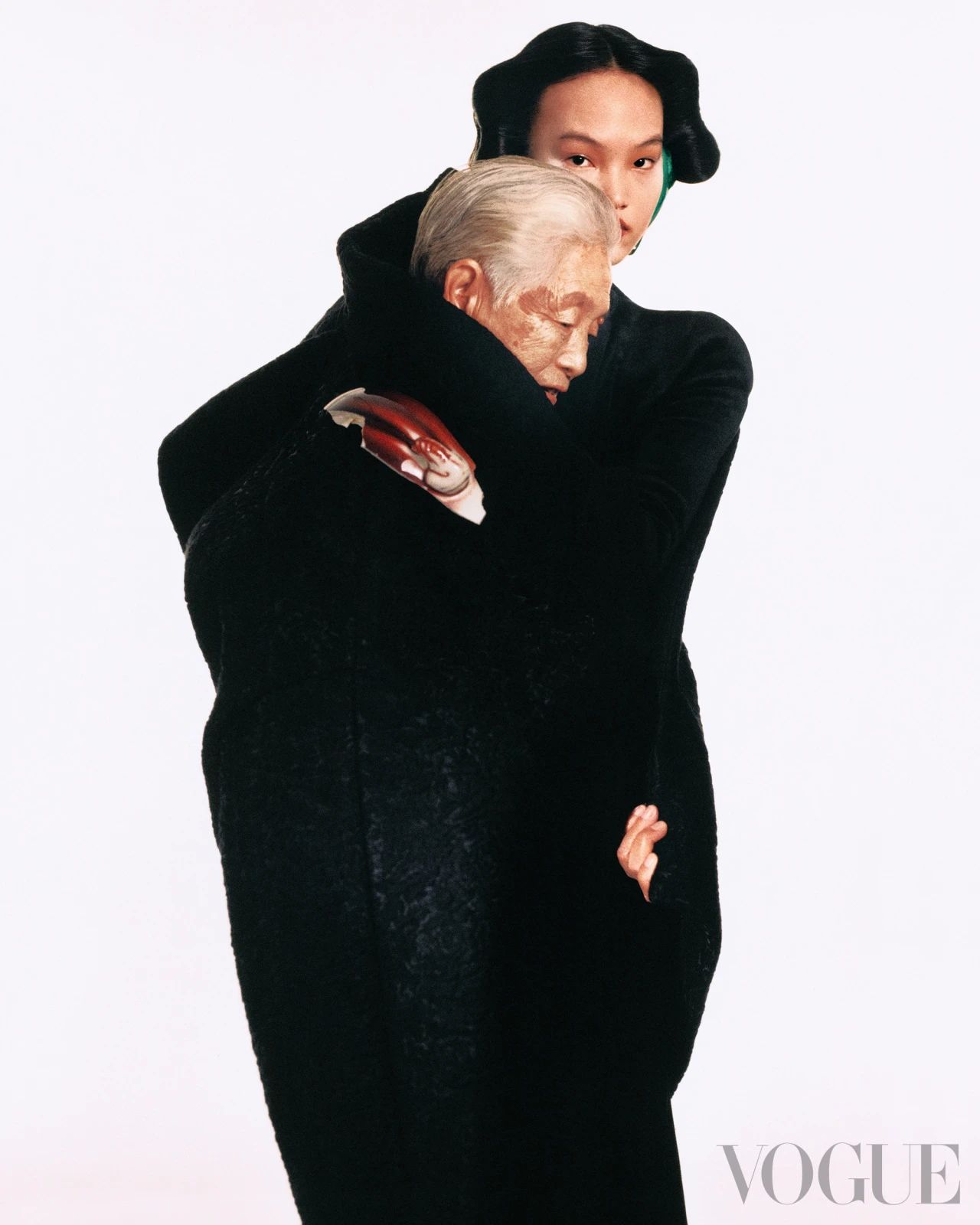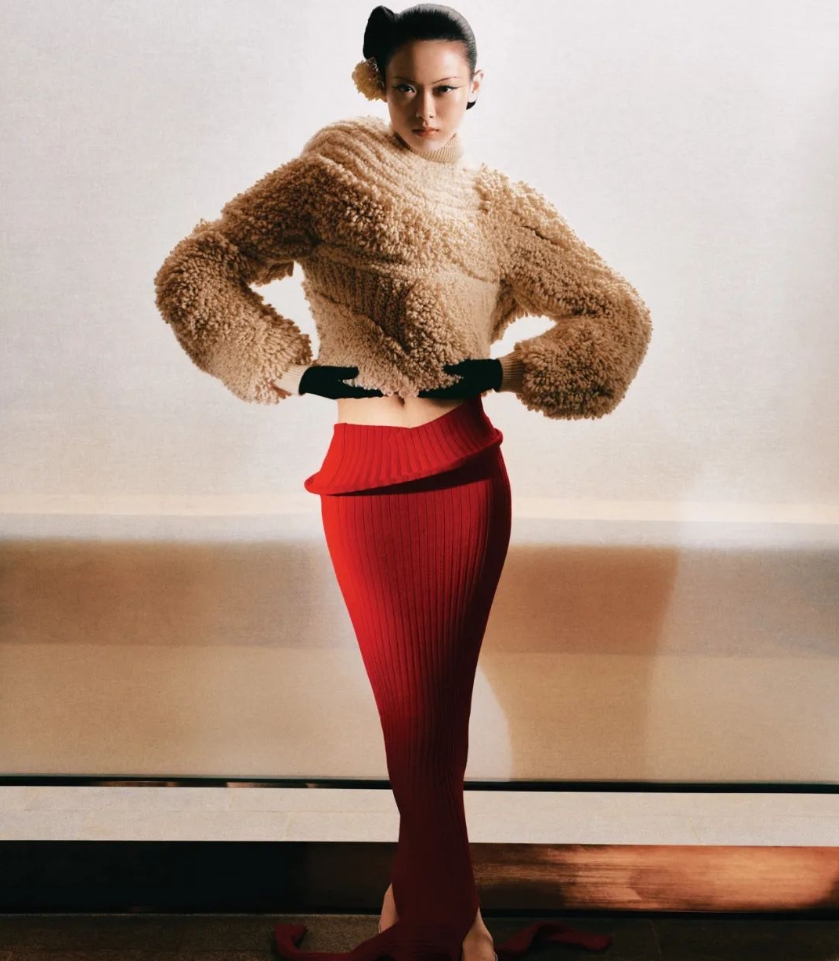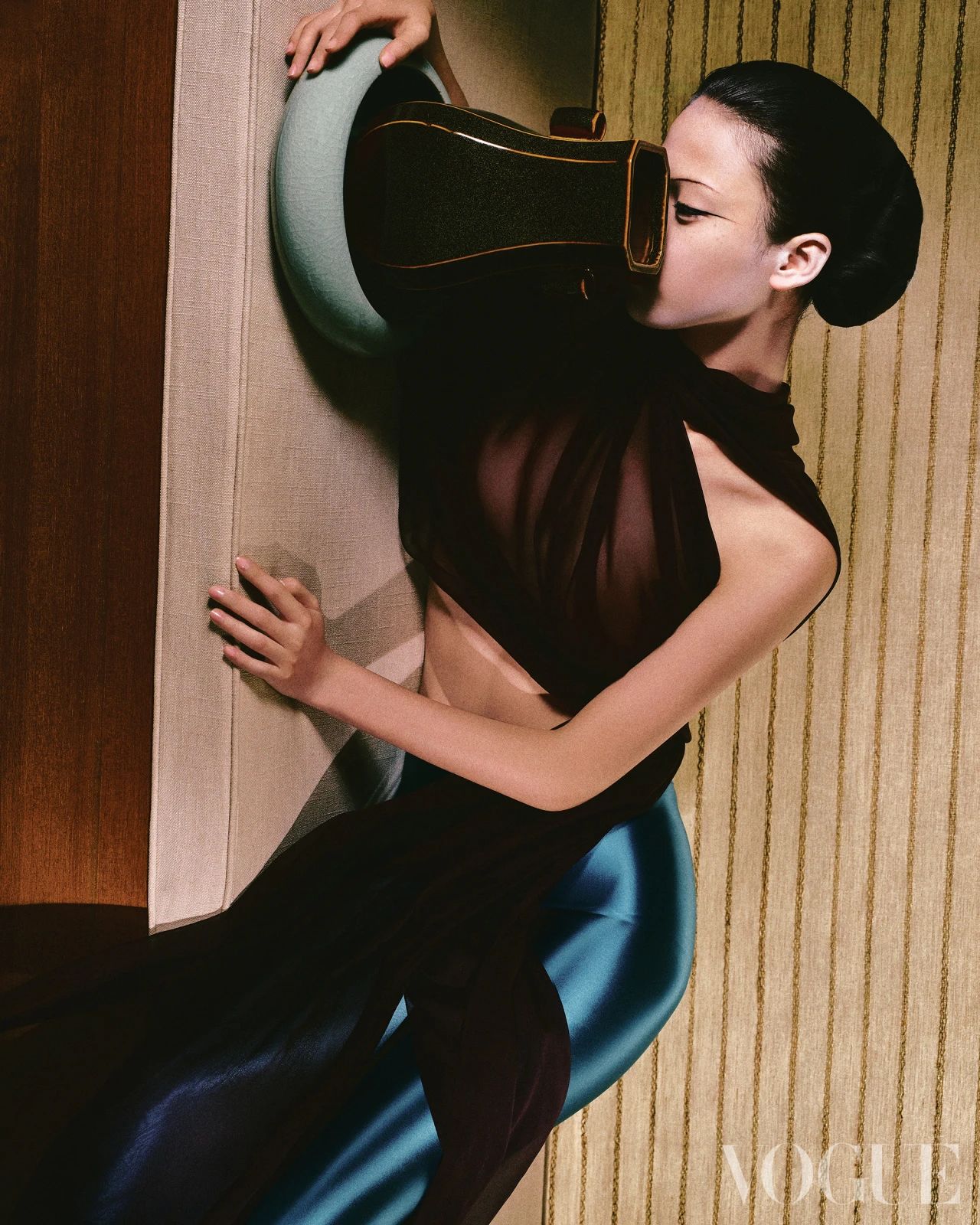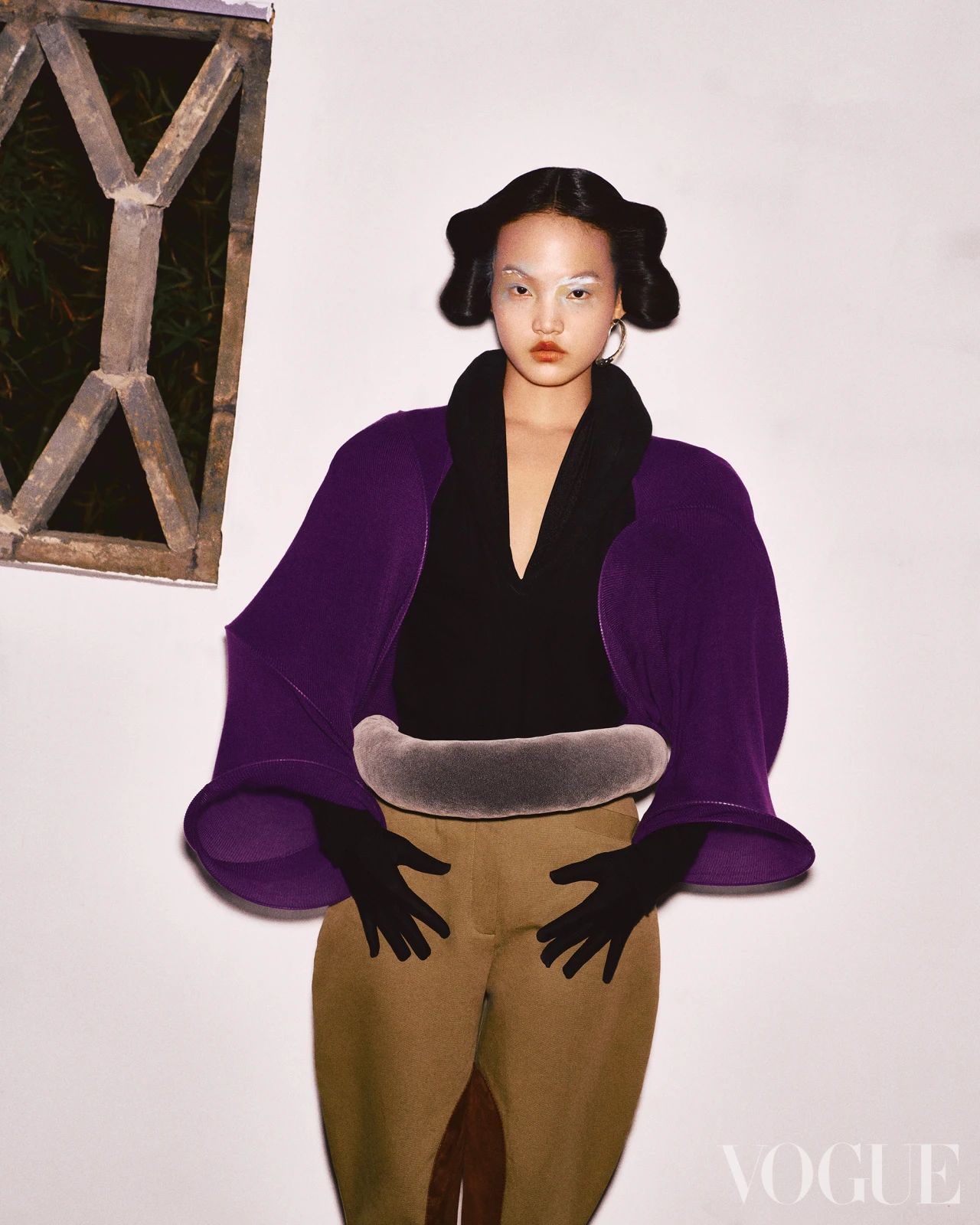Deng Xiping, the 81-year-old representative inheritor of monochrome glaze art, keeps curiosity. She integrates the territorial characteristics of Jingdezhen, explores the new practice of traditional crafts in the current context, and looks for more possibilities in public aesthetic education and fashion crossover with an open attitude.

Front (Deng Xiping): Black textured silhouette coat Maison Margiela
Rear: Black dress Balenciaga

Fashion’s dedication to traditional craftsmanship is not only reflected in the acquisition of aesthetic inspiration, but also in the excavation of craftsmanship and historical stories, which is also of great significance to its search for innovative directions.
In recent years, the creative director of the fashion house, Jonathan Anderson, has launched a series of works inspired by traditional Chinese monochrome glazed porcelain. The color inspiration of the traditional monochrome glazed ceramics of the Ming and Qing dynasties has been applied to Loewe’s iconic bags. It is based on the natural, classical, elegant and contemporary aesthetic color presentation, which undoubtedly arouses people’s look back on the traditional Chinese monochrome glazed ceramic technology. In order to show this ceramic craft treasure to more art lovers in China and even around the world, the Anderson specially invited Deng Xiping, chief engineer of Jingdezhen Jianguo porcelain Factory and representative inheritor of monochrome glaze, to present the modern colors in this series in the form of monochrome glaze admiralty bowls. There are many colors in the series that have never appeared in traditional Chinese monochromatic glaze, and this undoubtedly means a new process and a new exploration for monochromatic glaze that relies heavily on natural materials and precise firing control. Compared with the consumers who were amazed by these unique colors, Deng Xiping, who was 81 years old at that time, seemed to be used to it-because in the matter of firing monochromatic glaze, tradition will never be copied, but only innovation.

White feather earrings Jil Sander
Pink Printed Top Comme des Garc sons
Deng Xiping has been making monochromatic glazes for nearly 60 years. She admits that she “has never made two identical works”. Monochrome glaze has a long history in China, especially in the Song Dynasty, monochrome glaze entered a stage of vigorous development, and reached its peak in the Kang, Yong and Qian periods of the Qing Dynasty. After the founding of new China, monochrome glaze into the national focus on the traditional handicraft category. After graduating from the Department of Chemistry of Wuhan University, Deng Xiping was assigned by the state to enter the Jingdezhen Ceramic Research Institute of the Ministry of Light Industry. After a year of “college student labor training”, she was left in the color glaze group to learn from teachers, specializing in monochrome glaze technology.
“At that time, I was not convinced. Why did other college students work as assistant engineers in the department, but I wanted to be an apprentice in the color glaze group?” The old man recalled the past half a century ago, and his tone still had a little “youthful spirit”. Meaning. After joining the monochromatic glaze group, she realized that monochromatic glaze was “Jingdezhen’s first contribution to the country”. It turned out that as early as 1954, the Jingdezhen Ceramic Research Institute, which was still under the local jurisdiction at that time, received the task assigned by the state to summarize the production method of monochromatic glaze, make technical data, and exchange precision instrument manufacturing technology from other countries. Since that year, every year, college students from different universities and different related majors will be assigned to the monochromatic glaze group to learn from teachers and inherit the monochromatic glaze skills in Jingdezhen.

In the 1950 s, there was a basic technical summary, revealing the secret of traditional monochromatic glaze, that is, different trace metal elements in natural ores. For example, red glaze uses copper as colorant and lead as cosolvent. Yellow glaze uses iron as colorant; However, glaze with less iron may produce blue and white glaze. But for Deng Xiping at that time, the experience of the predecessors could only be regarded as “giving young people a crutch”, because nothing could be done completely according to the ready-made formula in the technical data. “The original ecology of ore is not repeated, it has a unique nature, because it is not refined or synthetic. When you use up the stone in a mine, and then dig out the composition and content are already different from the past”, Deng Xiping will be fired monochromatic glaze metaphor achievement as if the old Chinese medicine doctor, the predecessors gave the prescription, but the patient is ever-changing.
“We ‘ve actually been doing research. Color glazes in history are often dated. For example, the sacrificial red glaze (also known as ruby red glaze) in Xuande period cannot be made after Xuande, because the conditions have changed and there is no way to use new ores and materials to make the original colors.” For this reason, in his creation, Deng Xiping seems to have only restored the colors that existed in the history of monochromatic glazes, but in fact he is innovating glaze formulas that did not exist in the past. “At that time, apprentices stayed in the color glaze group to work, but they couldn’t do the ancestral glaze handed down by the teacher. After the apprentice left the school, he had to open up new glaze varieties to stay in the group to work. Some students couldn’t develop new glaze, so naturally they couldn’t stay.” In addition to the change of the raw material of the glaze itself, the change of the product shape and the change of the firing scale shrinkage ratio brought by the change of the firing condition also increase the difficulty of making the monochromatic glaze. Generally speaking, the firing of monochromatic glaze requires a high temperature of more than 1300 degrees, and every change in temperature will increase the difficulty of control several times. Porcelain firing pays attention to “atmosphere”. The state of the weather, the temperature, humidity, pressure of the air, the duration of firing, and the temperature are all unquantifiable experiences, and these difficulties have been overcome by Deng Xiping without exception.

In nearly 60 years of career, Deng Xiping has made numerous innovations, of which the most proud is the “lead-free red glaze” developed in 1976 “. In the past formula, due to the existence of lead components, making this glaze is very unfriendly to the health of producers, and lead-free glaze developed successfully, undoubtedly relieved the risk of lead poisoning of craftsmen. In addition to the technical aspects, many kinds of artistic innovations supported by technology are also amazing. “Monochromatic glaze works have no artificial painting process, they are actually natural, and the inspiration for our creation also comes from nature,” Deng Xiping said. When firing rose purple glaze, producers need to observe the different changes of roses in natural light in the morning, middle and evening, so that they can show the effect from red to purple but not black. This rose purple glaze color was founded in Jingdezhen official kiln in the Ming Dynasty. Due to the extremely low yield of firing, it has the alias of “cow’s head and horse’s face”, which means that it is difficult to grasp whether it is a cow or a horse. Even in the Qing Dynasty, its firing method failed to stabilize, but Deng Xiping succeeded. The rose-purple glazed barrel bottle created by her was treasured by the “Century Collection” project of the Chinese History Museum in January 2002.

Black cashmere shawl,
“DIOR LADY ART #8” Artist Limited Collaboration Series
MARIKO MORI cooperation handbags are Dior

Fire Red Metallic Drumstick Jacquard Fabric Straight Lace-up dress Herme s
“In the Song Dynasty, there was a blue glaze over the rain, a very quiet and pleasing color”, a glaze color somewhat similar to today’s Tiffany blue, inspired by the clear sky that cleared up after the rain. As a result, Deng Xiping has also developed a series of glaze colors inspired by the soft color changes in the sky. For example, in 2013, the secret glaze was bright red, like the bright glow in the sky. From different angles of the utensils, you can see the constantly moving parabolic smooth surface. Even if it is vacant, the inside of the lamp is like a clear spring water.

Different from the literal “monochrome”, monochromatic glaze can also make it show different textures with different shades and levels after firing. Speaking of such creation, Deng Xiping said with a smile: “In the 1970 s, designers who did flower cloth design came to us to look at various colors and the changes of natural patterns to inspire their own thinking. This is not also a” cross-border “with you to make fashion and clothing ‘!” Speaking of the cross-border fashion cooperation with Loewe last year, Deng Xiping also felt that he was not old in thought. “Without this cooperation, I would not have made these new attempts”.
In the past, in Jingdezhen Ceramic University, monochromatic glaze was not a separate major, but a course for students to take. With the support of the fashion brand, a new “Monochrome Glaze Ceramic Education Project” has taken shape, which allows more students interested in monochrome glaze to improve their skills in a more professional environment. When asked about the current craft inheritance of monochromatic glaze, Deng Xiping also seemed very relaxed. On the one hand, it is the strong support of the state; on the other hand, in these years, she has also seen that the younger generation is taking practical actions to inherit ancient skills.

Today, Deng Xiping still lives and works in Jingdezhen. In her view, Jingdezhen, as the porcelain capital of a thousand years, belongs not only to China, but also to the world, and its unique territoriality cannot be replaced. “A city, through only one product, can continue to develop for thousands of years without decline or stagnation. There is only Jingdezhen in the world.” This is precisely because Jingdezhen can constantly adapt to the needs of the times, constantly change, and adapt to the needs of modern people. And the current aesthetic concept. “There is also a fashion factor in tradition. Once fashion is preserved, it can become a classic and a tradition.”
(Source: VOGUE)













